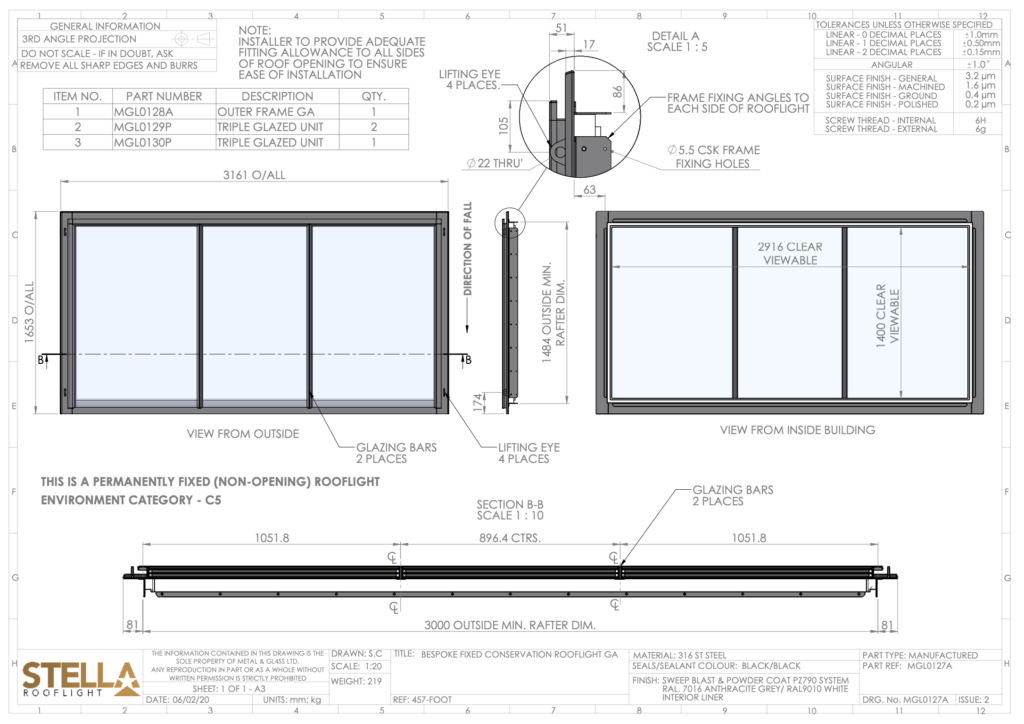After placing an order with a conservation rooflight company, the next step involves the issuance of an approval drawing. This drawing serves as a visual record of the rooflight, offering crucial details to everyone involved in the project. Especially important for bespoke conservation rooflights, the approval drawing ensures that the delivered product aligns with expectations, minimising surprises. This guide aims to highlight key points within an approval drawing, helping customers comprehend the information provided.
General Information: Approval drawings vary among companies, but they typically include unique details specific to your project. This encompasses information such as weight, size, frame material, sealant and tape details, paint finish, manufacturing tolerances, and drawing reference numbers.
It’s essential for customers to carefully review these drawings, ensuring alignment with prior discussions. Any discrepancies should be addressed with the manufacturer, and questions should be raised for clarification.
Drawings can be modified, usually at no extra cost, until customers are satisfied and ready to proceed with manufacturing. It’s vital for all involved parties, including architects and builders, to scrutinise the drawing and understand aspects like unloading, positioning, and fitting the rooflight before it arrives on site.

Appearance: The approval drawing should depict both the internal and external appearance of the rooflight. This includes details such as glazing bars, the internal liner, and, if chosen, any opening mechanisms. External frame measurements and clear viewable dimensions are typically provided on this page. Additionally, cross-sectional views may be included, showing width, height, and internal rafter dimensions for rafter spacing.
Additional information may cover wood type for the liner, colour references for painting, required roof pitch, and glazing specifications based on the rooflight size.
Size: Critical dimensions related to the rooflight’s size are outlined in the approval drawing:
Clear Viewable: The finished viewable size from the internal face of the liner after installation.
Rafter: The fixing size taken from the internal faces of rafters, determining the frame’s fixing position.
Overall: The external measurement of the rooflight from one outer edge to the other. Often covered by tiles or slates, this size may differ from the clear viewable size.
Weight: The total weight of the rooflight, including glazing but excluding the pallet or any lead flashing kit, should be specified in the drawing. Understanding the weight is crucial for logistical planning, ensuring proper unloading arrangements. The drawing guides customers on whether a mechanical lift or additional personnel are needed.
Lifting Eyes: For larger rooflights, some manufacturers may include lifting eyes for crane installation. These eyelets, clearly shown on the drawing, are positioned at the side or head section. Customers should discuss this with the manufacturer and, if required, ensure a spreader bar is used during installation. After the lift, the removable lifting eyes should be replaced with bolts, and a small bead of silicone can be applied.
Delivery & Storage: Given the size of bespoke rooflights, tail lift facilities may not be suitable for unloading. Customers must communicate access issues to the manufacturer to avoid complications. Coordination with the rooflight manufacturer for a scheduled delivery date is crucial, allowing adequate time for site preparation. If immediate installation isn’t planned, customers should arrange suitable dry storage for the rooflight.

